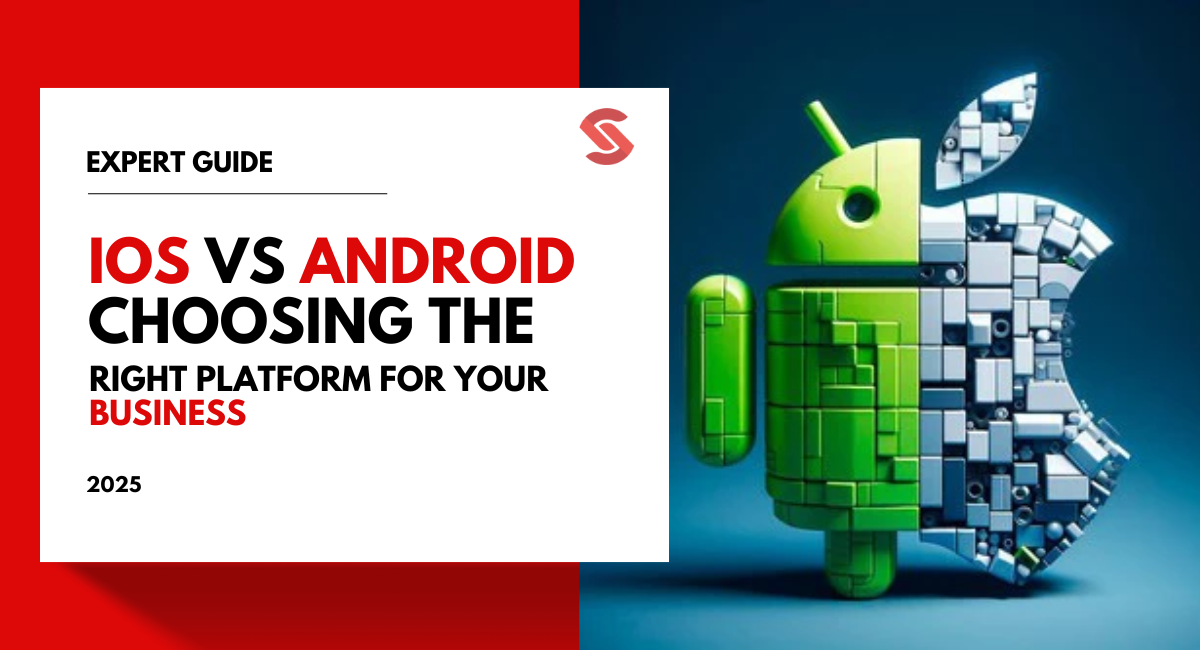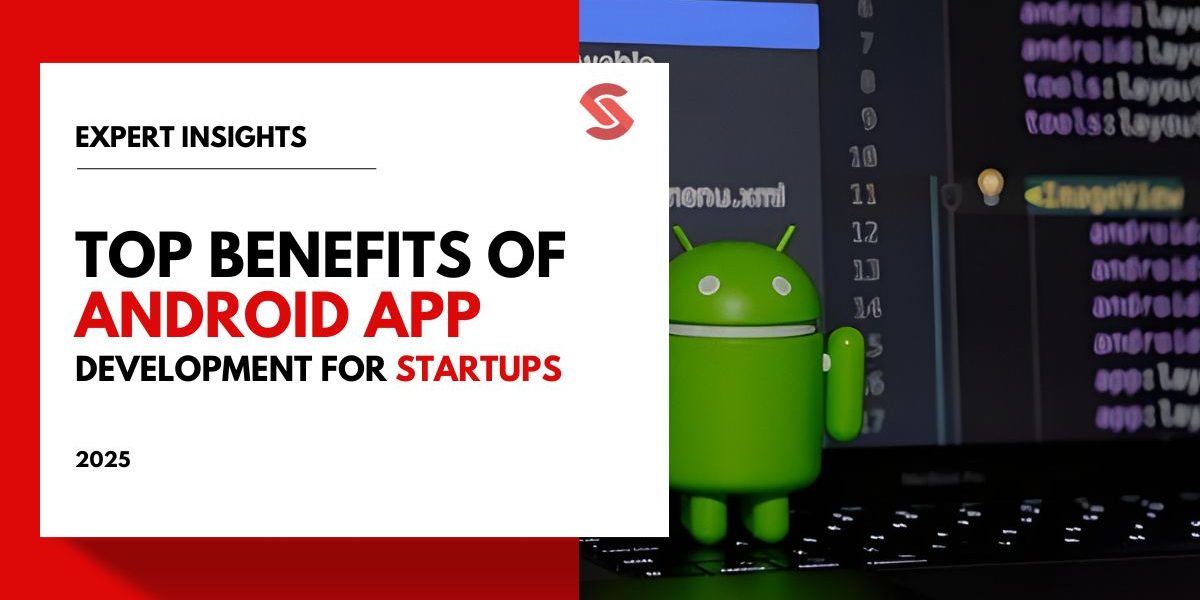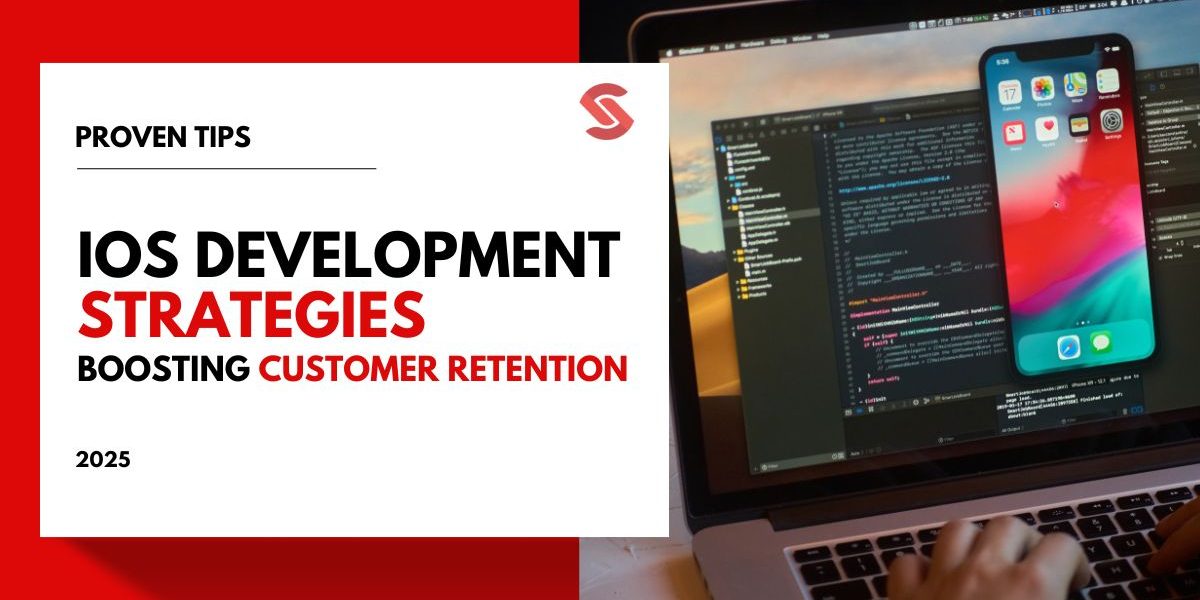If you’re planning to develop an app, likely countless questions must be popping up before you start your research and development. But there’s one question that stands out above all others: which platform should you choose, iOS or Android?
Both options come with unique strengths and challenges, and the right choice depends heavily on factors like your target audience, development budget, and long-term goals.
In this blog, we’ll break down the key differences between iOS and Android to help you make a decision that best aligns with your business objectives.
Why the Right App Platform Matters for Your Business
When developing a mobile app, the choice between iOS and Android platforms can have a big impact on your business’s success. The platform you select will influence your app’s reach, user experience, development costs, and overall profitability.
For companies looking to thrive in the competitive market, aligning your platform decision with your strategic goals is important. Factors like market share, target audience, revenue potential, and brand fit must be carefully considered.
By choosing the platform that best matches your objectives, you can set your app up for long-term growth and position your business for success in the app development market.
Understanding the Differences Between iOS and Android
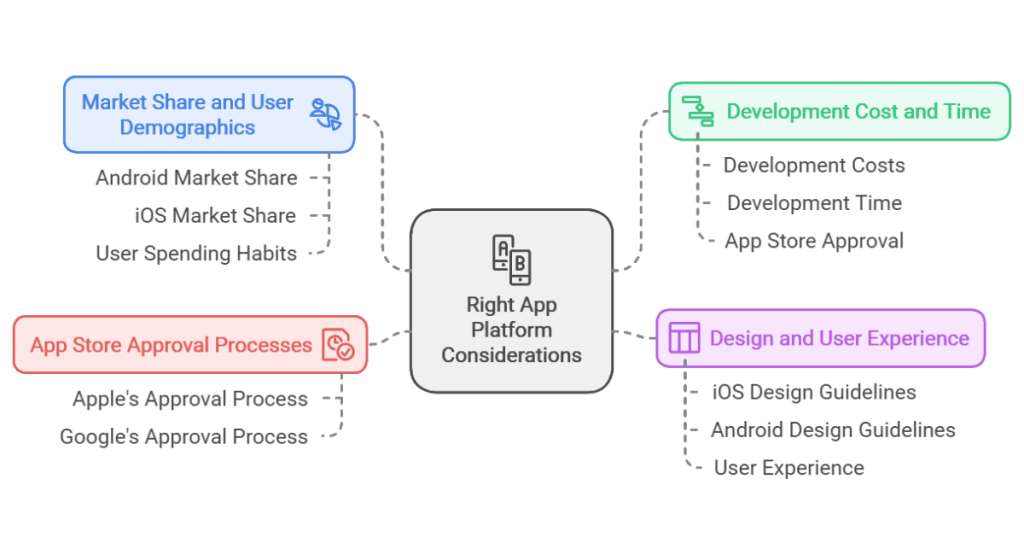
iOS and Android differ in design, development, and audience reach. iOS apps follow Apple’s Human Interface Guidelines, focusing on simplicity, while Android uses Material Design for customization flexibility.
iOS apps are typically built in Swift, and Android apps use Kotlin. Device compatibility is simpler on iOS due to fewer devices, but Android’s wide range supports a broader audience.
App store rules and approval times also vary, impacting launch timelines. These differences shape each platform’s development approach and user experience.
Market Share and User Demographics
When comparing iOS and Android users in terms of spending habits and market demographics, the contrasts are noteworthy. Globally, Android holds the highest market share due to its broad reach across diverse, affordable devices, particularly in regions like Africa (86% of the market) and Asia (80%).
On the other hand, iOS maintains a strong presence in wealthier regions like North America, where it holds around 44% of the market. iOS users contribute to around 68% of all mobile app spending worldwide, reflecting their preference for paid and premium apps over Android users, who tend to prefer free apps
Development Cost and Time Considerations
When developing an app, the differences between iOS and Android can significantly impact your budget and timeline. Building an iOS app typically requires a higher upfront investment due to the specialized Swift coding language and keen design standards enforced by Apple.
Conversely, the open-source nature of Android, with its Kotlin-based development, often allows for a more cost-effective approach. However, the diverse range of Android devices necessitates additional testing and compatibility checks, which can affect the overall development timeline.
Another consideration is the app store approval process, while Apple’s rigorous review can take several weeks, the Google Play Store generally has a faster turnaround, though with a less curated environment. Both platforms have specific time requirements that influence the app development timeline, from initial concept to final approval.
Design and User Experience Differences
The look and feel of mobile apps can vary differently between iOS and Android. iOS follows Apple’s strict Human Interface Guidelines, emphasizing a clean, simple aesthetic and intuitive navigation.
Android, on the other hand, is compatible with Google’s flexible Material Design principles, allowing for more customization and a dynamic user experience. These platform-specific design guidelines impact everything from button placement and menu structures to animation and interaction patterns.
It is important to understand and adapt to these differences to create a smooth and ideal user experience across all platforms. By recognizing the unique design philosophies of iOS and Android, you can create apps that not only delight your users but also stand out in the competitive mobile marketplace.
App Store Approval Processes
The app approval processes for the App Store and Google Play Store have distinct guidelines and timelines, reflecting Apple’s more stringent policies and Google’s relatively flexible approach.
Apple’s App Store generally emphasizes quality control and security, leading to a longer, more meticulous review, while Google’s Play Store aims for a faster turnaround with broader app acceptance.
Business-Specific Factors to Consider in Platform Selection
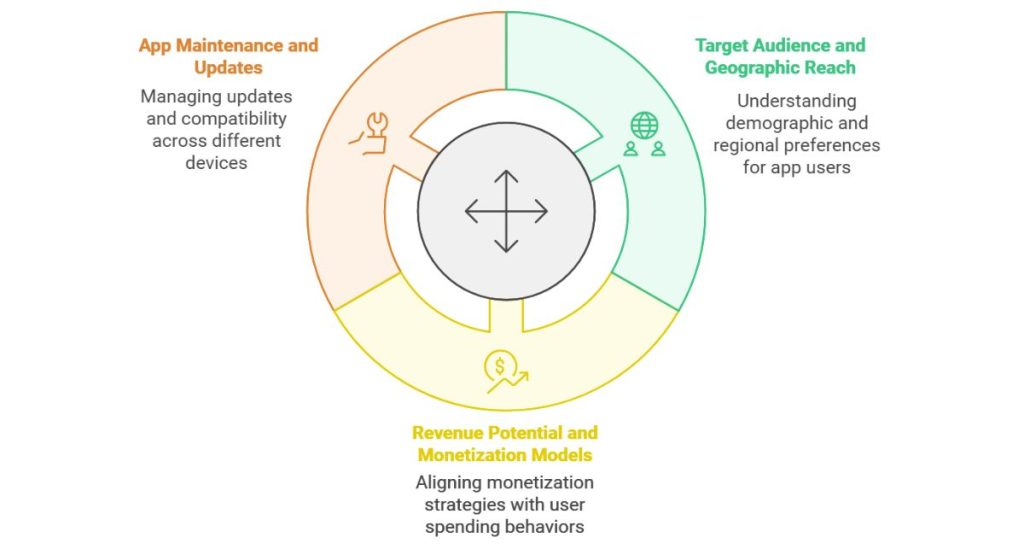
When deciding between iOS and Android for app development, companies should take monetization objectives, budget, and target audience into account. The selection process is aided by knowledge of audience demographics (iOS for affluent areas, Android for a wider audience) and device compatibility requirements.
Financial limitations also come into play because Android development frequently necessitates more extensive testing across devices. Apart from that, monetization options differ, with iOS favoring in-app purchases and Android being more ad-driven.
1. Target Audience and Geographic Reach
When selecting a platform for app development, understanding the target audience and regional preferences is essential. iOS users are primarily concentrated in North America and Western Europe, often with higher incomes and a preference for premium apps.
On the other hand, Android dominates in Asia, Africa, and Latin America, with its range of budget-friendly devices appealing to a broad audience.
These regional and demographic trends help businesses align their platform choice with audience reach, ensuring they maximize engagement and cater effectively to user preferences based on geographic and economic factors.
2. Revenue Potential and Monetization Models
Revenue potential varies significantly between iOS and Android, driven by different user behaviors and monetization models. iOS users tend to spend more on in-app purchases and subscriptions, making it ideal for apps relying on these models.
Android, meanwhile, excels in ad-based revenue due to its larger user base in markets where free, ad-supported apps are popular.
“iOS users spend nearly twice as much on in-app purchases as Android users,” notes Peggy Anne Salz, mobile marketing expert, emphasizing iOS’s strength for premium revenue models. Choosing the right platform depends on aligning with these spending behaviors to optimize revenue potential.
3. App Maintenance and Updates
Maintaining and updating apps on iOS and Android differs due to platform-specific requirements. Apple’s iOS has a consistent update schedule, often rolling out updates annually, which helps streamline compatibility.
However, Android’s diverse devices require more extensive testing for compatibility, as updates reach devices at varying times depending on manufacturer schedules.
Key Differences in App Maintenance and Updates:
Update Frequency:
- iOS: Apple’s yearly updates simplify the process, though apps may need adjustments to match new iOS features.
- Android: Device and OS fragmentation mean updates roll out gradually, requiring developers to account for multiple versions.
Compatibility Testing:
- iOS: Consistent across fewer devices, making compatibility easier to manage.
- Android: Requires testing across a broader range of devices and OS versions.
Bug Fixes and Lifecycle:
- iOS: Faster, more predictable updates aid in addressing issues quickly.
- Android: Slower OS updates can delay bug fixes for certain devices, extending the maintenance timeline.
Platform-Specific Benefits for iOS and Android
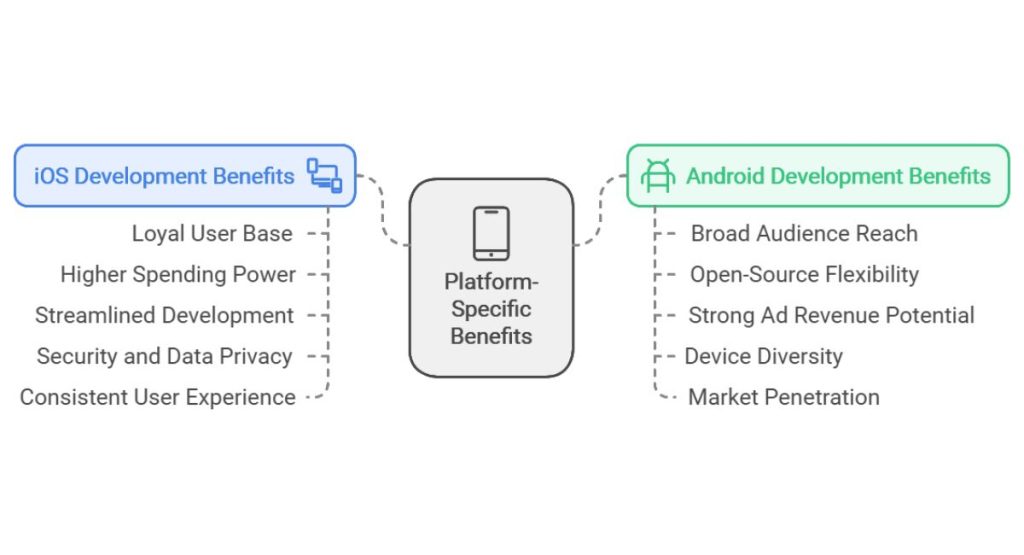
iOS and Android each offer unique benefits that can help businesses align with specific audiences and monetization goals.
iOS is known for strong user loyalty, high in-app spending, and faster, consistent updates, making it ideal for premium or subscription-based apps. On the other hand Android dominates in global reach, flexible ad revenue potential, and wide compatibility across many device types.
These platform-specific advantages allow businesses to tailor their app strategy based on user demographics, market reach, and preferred monetization models, ensuring an effective approach to audience engagement and revenue generation.
Benefits of Developing for iOS
iOS development offers several advantages for businesses targeting a premium user base. With high user loyalty, an easy development process, and consistent updates, iOS enables efficient monetization and a secure, user-friendly experience.
Key Benefits of iOS Development:
- Loyal User Base: iOS users show high retention rates, encouraging long-term engagement.
- Higher Spending Power: iOS users generally spend more on in-app purchases and subscriptions.
- Streamlined Development: Apple’s controlled device ecosystem allows for efficient testing across fewer models.
- Security and Data Privacy: iOS emphasizes robust data privacy and security protocols, appealing to privacy-conscious users.
- Consistent User Experience: Regular updates and standard guidelines ensure a polished, consistent app experience.
Benefits of Developing for Android
Android development provides access to a vast, diverse user base, with customization options and significant ad revenue opportunities. It’s an ideal choice for apps targeting a global audience with varied device and feature requirements.
Key Benefits of Android Development:
- Broad Audience Reach: Android’s widespread use in Asia, Africa, and Latin America ensures broader access.
- Open-Source Flexibility: The platform allows extensive customization, making it versatile for unique app features.
- Strong Ad Revenue Potential: Android’s global user base makes it ideal for ad-supported monetization models.
- Device Diversity: Compatibility with a variety of devices lets Android apps reach diverse market segments.
- Market Penetration: Android’s affordability enhances accessibility, particularly in emerging markets.
These advantages help businesses choose the platform that best fits their goals, user demographics, and preferred monetization model.
Cross-Platform Development: A Viable Alternative?

Cross-platform development has emerged as a viable alternative to native app development because it uses a single codebase, and businesses can deliver consistent experiences across iOS and Android platforms, boosting development speed and reducing costs.
Popular cross-platform tools like Flutter and React Native enable code reuse, simplifying maintenance and updates. This approach helps businesses maximize their reach and engagement across multiple platforms, ultimately driving better returns on investment.
Apart from that according to a 2023 Gartner report, the global cross-platform mobile development market is projected to grow at a CAGR of 14.5% from 2022 to 2027, highlighting the increasing adoption of these solutions.
Pros and Cons of Cross-Platform Development
Cross-platform development allows businesses to build apps for both iOS and Android with a single codebase, offering time and cost efficiency. Frameworks like Flutter and React Native make it possible to deploy on multiple platforms with a shared code, but they come with some trade-offs in performance and platform-specific customization.
Pros of Cross-Platform Development:
- Cost Efficiency: Reduced development costs since one codebase serves both platforms.
- Faster Deployment: Speeds up the process by allowing simultaneous updates and releases on iOS and Android.
- Wider Audience Reach: Accessible to users on multiple platforms without separate development efforts.
- Consistent User Experience: Shared design components help maintain a unified look and feel across devices.
Cons of Cross-Platform Development:
- Performance Limitations: May lack the responsiveness and smoothness of fully native apps, especially for complex features.
- Platform-Specific Customization: Limited ability to fine-tune experiences for each OS due to shared code.
- Dependency on Framework Updates: Frameworks like Flutter and React Native require regular updates, which can impact compatibility.
- Larger App Size: Cross-platform frameworks can increase the app’s file size, affecting download speed and storage.
When Cross-Platform Development Makes Sense
For businesses aiming to launch MVPs, test market potential, or work within a budget, developing an app for both iOS and Android simultaneously can be highly effective.
Using frameworks like Flutter or React Native enables rapid prototyping, allowing teams to release an app quickly and gather valuable user feedback across platforms.
This approach minimizes development costs, making it an ideal choice for companies wanting to evaluate market interest or deliver core features broadly without the investment required for separate native builds.
Why Softnix is the Best Choice for iOS and Android App Development
When planning an app, one major question is how to find the right development partner. But you don’t need to worry because Softnix is here to save the day!
With extensive expertise in iOS and Android, Softnix provides end-to-end app development services designed to deliver high-quality, user-focused apps that drive results. Our team’s experience and dedication ensure your app journey is smooth and successful.
But What Softnix is the Perfect Choice for App Development:
- Full Support: Guidance through every project stage.
- ROI-Driven: Development strategies for maximum impact.
- Platform Expertise: Deep knowledge of iOS and Android.
- Experienced Team: Proven track record across industries.
- User-Centered Design: Focus on engagement and retention.
- Quality Assurance: Rigorous testing for flawless performance.
Key Takeaways for Your Business to Make the Right Choice
The choice between iOS and Android platforms significantly impacts your app’s success, market reach, and revenue potential. Each platform offers unique advantages, iOS excels in premium markets with higher user spending, while Android provides broader global reach and flexibility.
Before making a decision think about your target audience, budget constraints, and business objectives carefully. Whether you choose native development or explore cross-platform solutions, ensure your decision aligns with your long-term goals and user expectations for better results in per current competitive mobile app market.
FAQs
Which is better for business apps, iOS or Android?
The choice depends on your target audience, location, and device preference. iOS is popular in developed markets, while Android dominates in emerging markets. iOS often leads in user engagement and app revenue, but Android’s reach is broader globally.
What factors should I consider when choosing between iOS and Android?
Consider target demographics, budget, monetization strategy, and platform-specific strengths. iOS users generally have higher spending power, while Android’s broader device variety suits diverse global audiences. Development time and costs also vary between the two.
How does the cost of developing for iOS compare to Android?
Development costs can be similar, but Android apps may require more resources due to device fragmentation. Testing on various Android devices increases time and cost, whereas iOS, with fewer devices, generally incurs lower testing expenses.
Is iOS or Android better for user engagement?
iOS users tend to have higher engagement rates and spend more on in-app purchases. Android’s larger user base brings more reach, but its engagement metrics typically fall below iOS in terms of spending and user retention.
Which platform has a higher ROI: iOS or Android?
iOS often yields a higher return on investment, particularly in premium markets like the U.S. and Western Europe. However, Android can offer strong ROI in emerging markets with its broader user base and affordable device options.
What are the main differences between iOS and Android development?
iOS uses Swift or Objective-C, while Android uses Kotlin or Java. The development time for Android is often longer due to device fragmentation, and UI/UX guidelines vary, with iOS favoring simplicity and minimalism and Android promoting flexibility.
How does app approval differ between the App Store and Google Play?
Apple’s App Store has a more rigorous approval process, often requiring longer review times and stricter adherence to guidelines. Google Play offers a quicker approval process but may be less strict in its initial review.
Are there more users on iOS or Android globally?
Android has a significantly larger global user base, especially in emerging markets. iOS leads in the U.S., Canada, and Australia, but Android is dominant in Asia, Africa, and Latin America.
Which platform is more profitable for app developers?
Generally, iOS is more profitable per user, as Apple’s user base spends more on in-app purchases. However, Android’s broad user base offers more opportunities for ad revenue and reach in certain regions.
How does UI/UX design differ between iOS and Android?
iOS focuses on uniformity with strict design guidelines, using standardized elements like navigation bars. Android is more flexible, allowing unique design approaches, but it’s also more challenging due to device variety and screen sizes.
Can I develop an app for both iOS and Android at the same time?
Yes, with cross-platform tools like Flutter or React Native, simultaneous development is feasible. These tools help deliver a native-like experience on both platforms but may have limitations compared to fully native apps.
How does app maintenance vary between iOS and Android?
iOS app maintenance is generally easier due to limited device models and standardized OS updates. Android requires more upkeep due to device fragmentation and varying update schedules across manufacturers.
Is it easier to build a cross-platform app or a native app?
Cross-platform apps save time and cost but may sacrifice performance and customization. Native apps offer better performance and platform-specific features, especially for complex applications, though they require separate development efforts.
Do iOS users spend more on apps than Android users?
Yes, iOS users tend to spend more on paid apps, subscriptions, and in-app purchases, contributing to a higher average revenue per user compared to Android.
What are the security differences between iOS and Android for business apps?
iOS generally offers tighter security with closed-source architecture and strict app review processes. Android, while open-source and flexible, requires additional measures to secure apps across diverse device models and OS versions.

